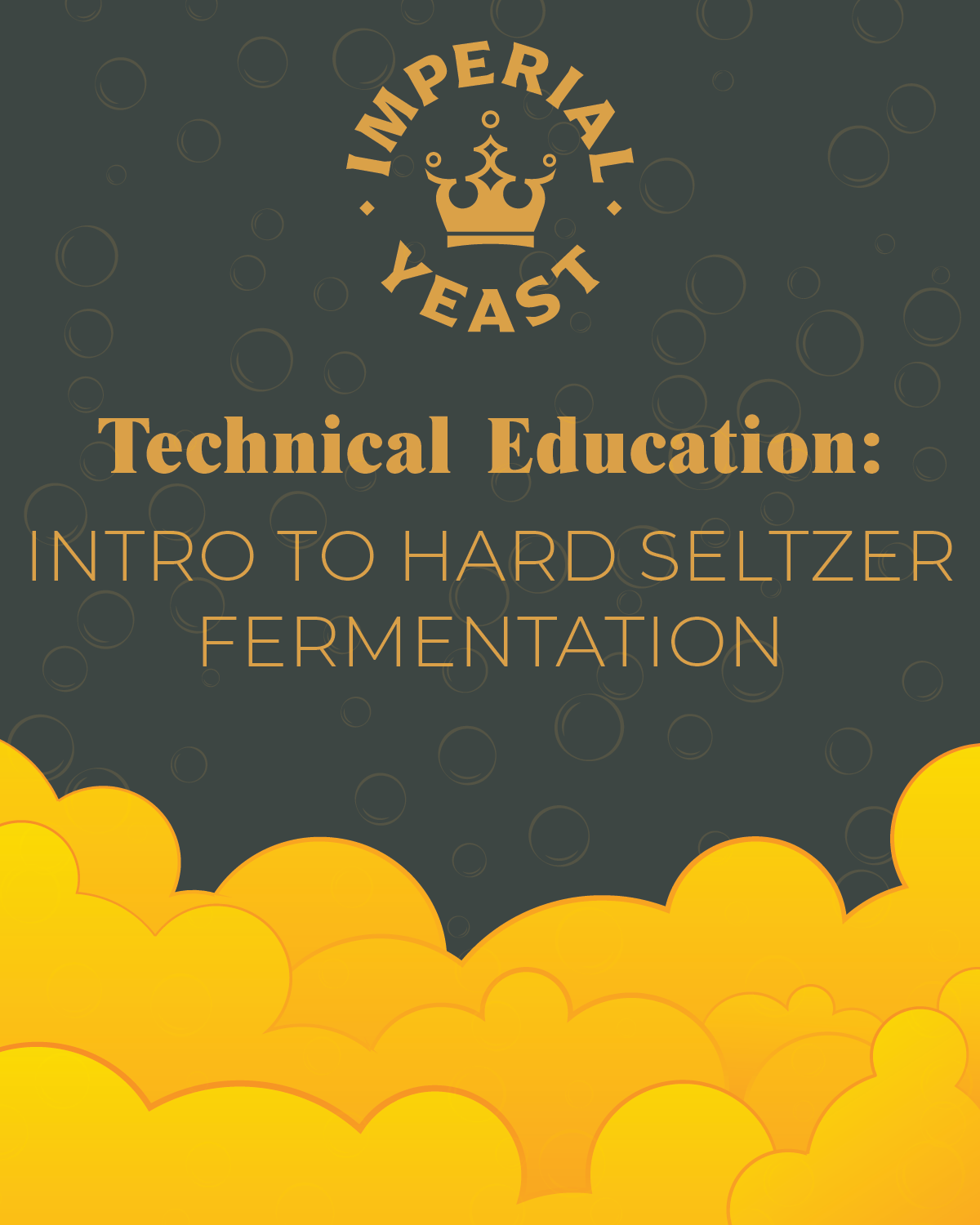Hard seltzer is a carbonated alcoholic beverage made by fermenting a form of sugar water until there is essentially nothing left except for alcohol, water, and bubbles. The result is a dry, refreshing, often flavored alcoholic beverage that has seen a surge in popularity in the last five years.
Two production methods are most commonly employed by breweries: Fermenting a relatively low gravity base to achieve 4-5% ABV at the end of fermentation, and fermenting a higher gravity base to achieve a product with an elevated ABV, which is often then diluted down to a lower ABV.
The main obstacles with seltzer fermentations stem from the fact that the base is often made with a simple sugar like dextrose, and is thus lacking nitrogen and essential minerals. The sugar water base must be supplemented with appropriate levels and types of nutrients, as well as some form of buffer to control the pH during fermentation.
Finally, fermentation is typically carried out using a robust yeast strain with a relatively neutral flavor profile. The selected yeast strain must be suited to fermenting a simple sugar base with minimal production of off-flavors. Appropriate pitching rates must be applied to ensure a complete, timely, and clean fermentation.
Water Matters!
Using reverse osmosis (RO) water allows the brewer to start with a blank slate, something that can be helpful when making seltzer. Since there are relatively few elements that go into a seltzer base, any impurities or significant mineral content that source water has can drastically affect the fermentation and flavor profile of a seltzer.
When RO water isn’t an option, best practice is to obtain a water report to understand what the water profile is. Alkalinity is often reported as “mg/L as CaCO3”, and in the range of 100-200 mg/L can be helpful for buffering the fermentation and ensuring the pH doesn’t drop too low.
If using RO water, an addition of Potassium bicarbonate or another buffering salt may be necessary to keep the fermentation pH above 3.5, in a range tolerable to the yeast.
Sugar: Keep it Simple
Many different types of sugar can be employed for seltzer fermentation, however dextrose is the most straightforward, as it is widely available, affordable, and easily metabolized by yeast for clean fermentations.
Sucrose is not recommended as a first choice for most yeast strains. Sucrose may leave behind residual fructose, which can have an impact on final flavor profiles.
More complex sugar sources like honey and agave syrup will often have notable effects on the sensory profile of the final product. Whether these effects are desirable or not depends on the goals for the product being made.
Yeast
Proper selection of a yeast strain for a seltzer can vary based on the target profile of the product. However, yeast strains that are pH and alcohol tolerant and work well with nutrient voids should be considered first.
Fermentation
Warm, fast fermentations can result in production of undesirable higher alcohols that are difficult to remove once in solution. Fermentation temperatures between 65-74ºF will result in a cleaner, predictable fermentation without excessive tank residency time.
Monitor pH regularly, additional buffer may need to be added to keep the pH above in the 3.5-4.5 range. Dissolve buffering salts before addition.
Oxygen
Oxygen rates should be similar to beer wort. Target a wort dissolved oxygen of 12-15ppm for an original gravity <20ºP.
Nutrients
Supplementing the sugar water base with a form of nitrogen, vitamins, and minerals is necessary for a successful seltzer fermentation. There are multiple supplementation options available to a brewer; the fermentation parameters and goals for the product will dictate which option is most suitable.
Types of Nutrients
Pure Inorganic Nitrogen*
- Rapid fermentation
- Potential off-flavors (aldehydes, higher alcohols, sulfur compounds)(toxic substances w/Urea)
- Low buffering capacity
- Not a source of zinc and magnesium
Organic Nitrogen**
- Predictable fermentation
- Clean flavor profiles
- More buffering capacity
- Source of zinc and magnesium
- May cause slight discoloration of the product
Hybrid***
- Vigorous fermentation
- Less potential for off-flavors
- Moderate buffering capacity
- Moderate source of zinc and magnesium
* Diammonium Phosphate (DAP)
** Yeast extract, or yeast autolysate, with vitamins and trace minerals
*** Inorganic (DAP) and organic (yeast autolysate) nitrogen, and vitamins
Recommended Pitch Rates
OG <15°P = .75-1.0 million cells/mL/*P
OG >15°P = 1-1.5 million cells/mL/*P
We recommend pitching yeast at a rate that takes into consideration the starting gravity of the base sugar water. For starting gravities below 15ºP, it’s advisable to pitch at a rate of 0.75 million cells/ml/ºP. When the starting gravity is above 15ºP, increasing the pitch rate to 1.0 million cells/ml/ºP will help ensure a timely, complete, and clean fermentation.
Imperial Seltzer Friendly Strains
* Use strains that perform well in simple sugar fermentation*
| Temperature: | 56-65°F (13-18°C) |
| Attenuation: | 73-77% |
| Flocculation: | Low |
| ABV(%): | 10% |
| Temperature: | 56-74°F (14-23°C) |
| Attenuation: | 65-100% |
| Flocculation: | Low |
| ABV(%): | 12% |
| Temperature: | 55-77°F (14-25°C) |
| Attenuation: | 85-100% |
| Flocculation: | Medium |
| ABV(%): | 10% |
